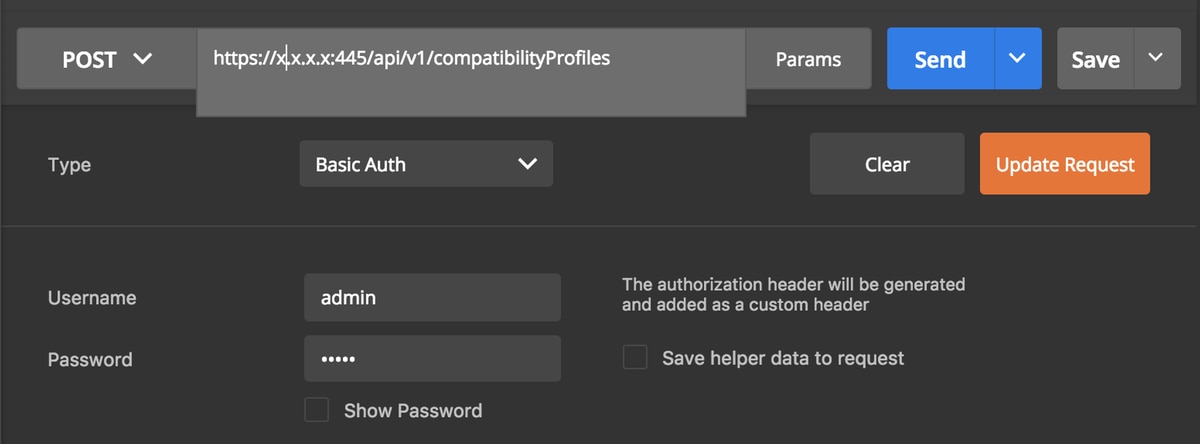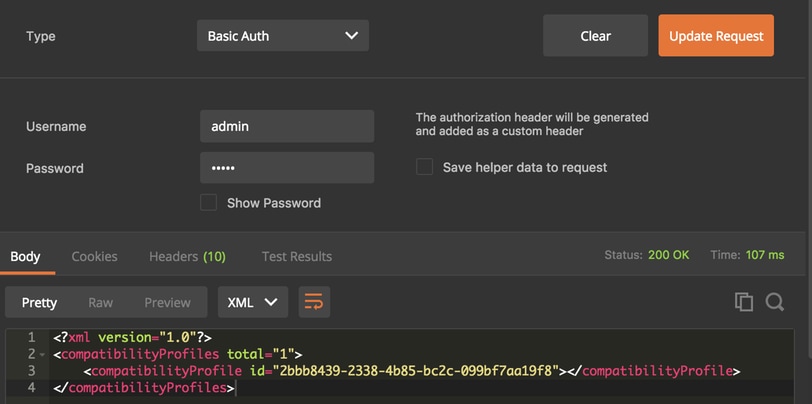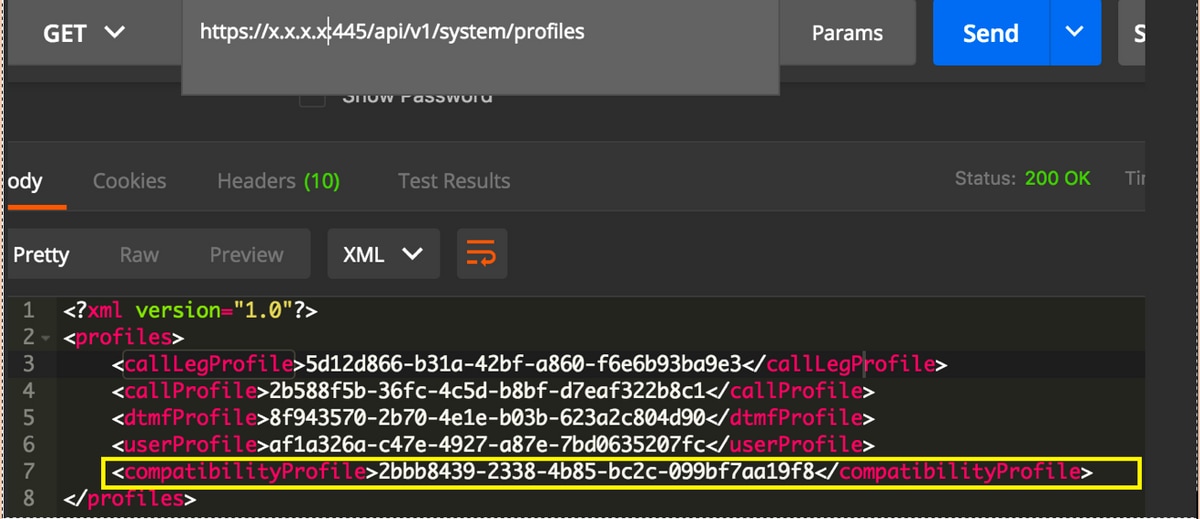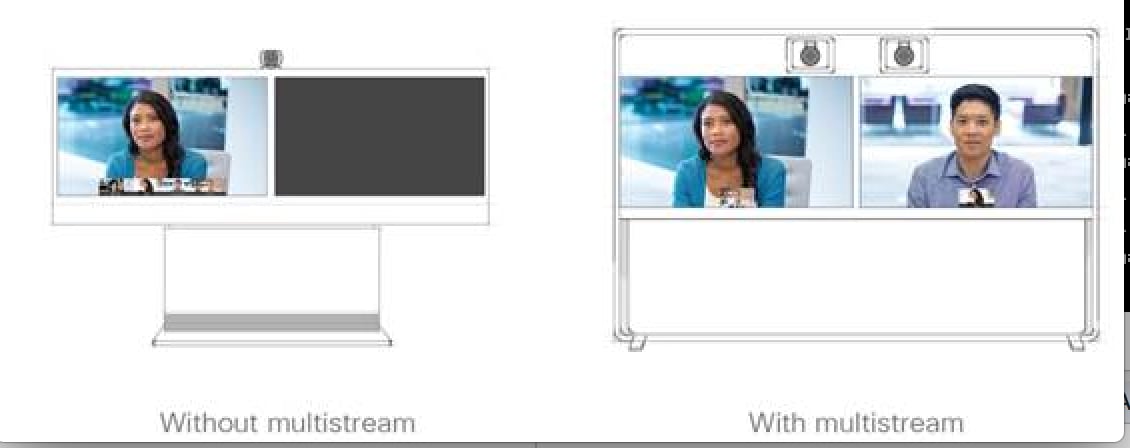Configure and Troubleshoot Dual Screen Feature
Available Languages
Download Options
Bias-Free Language
The documentation set for this product strives to use bias-free language. For the purposes of this documentation set, bias-free is defined as language that does not imply discrimination based on age, disability, gender, racial identity, ethnic identity, sexual orientation, socioeconomic status, and intersectionality. Exceptions may be present in the documentation due to language that is hardcoded in the user interfaces of the product software, language used based on RFP documentation, or language that is used by a referenced third-party product. Learn more about how Cisco is using Inclusive Language.
Introduction
This document describes how to setup Dual Screen feature with Cisco Meeting Server (CMS) and Cisco Telepresence Endpoints.
Prerequisites
Requirements
Cisco reommends that you have a knowledge of these topics:
- Callbridge component must be configured on CMS
- CMS must be running version 2.2.3 or later
- CE endpoint must be running CE9.1.3 or later
- Cisco Unified Communications Manager (CUCM) must be running 11.5.1 or later
- Calls routed via Expressway must have Expressway running 8.9 or later
- Calls must be working with CMS
Components Used
This document is not restricted to specific software and hardware versions:
- CMS API (Application program interface)
- Postman (or any other API client)
- CUCM
- CMS
- Cisco Telepresence Endpoints (SX, MX)
- PuTTY Secure Shell (SSH) terminal emulation software for Mainboard Management Processor (MMP)
- A web browser such as Firefox, Chrome
The information in the document created from the devices in a specific lab environment. All of the devices used in this document started with a cleared (default) configuration. If your network is live, ensure that you understand the potential impact of any command.
Configure
Step 1. Set up an administrator user account with API permission or can use the administrator account for Cisco Unified Communications Manager. Please find how to create a user with API access.
You can create additional user accounts for the MMP that have admin level rights using the MMP
Add user command user add <account name> <role>.
- SSH into the MMP.
- Add an admin level user account, for example

Step 2. Configure CMS to support dual screen feature using API.
POST, parameter compatibilityProfiles.
POSTMAN API is used but any API tool can be used for configuration.

Step 3. Use GET operation to get the unique id for compatibilityProfiles/<compatibilityProfiles id>.

Step 4. Use PUT operation for sipMultiStream=true.

Step 5. Apply the configured compatibilityprofile under system/profiles. This is applied to the profile at top level and isused as global profile.

This image shows the compatibilityprofile being applied successfully.

The above is the required configuration to setup DualScreen feature on CMS. Now, you need to also configure an ednpoint with required configuration. The endpoint must run CE9.1.3 or later version of software code.
Step 6. MultiStream Mode on an endpoint must be set as AUTO as shown in this image.

Step 7. On Call Manager when configuring Sip trunk please keep in mind the sip profile used must have following parameters.
SDP Transparency Profile Pass all unknown SDP attributes.

IX, must be enabled on the Sip Profile for trunk.

On Call Manager for endpoints, the Sip Profile used should be either Standard SIP Profile For TelePresence Endpoint or if you customize the sip profile to use for endpoints ensure that you have these parameters checked.

Note: When the system is in a three-screen setup, for example the Cisco Telepresence SX80, MX700 or MX800, the third screen is reserved for content while in a dual screen call.
Verify
Use this section in order to confirm that your configuration works properly
Consider, SX, MX700/800 to work as a dual screen endpoint. The layout of participants would appear as shown in the image and if you have an additional third monitor connected, the presentation should appear on the third monitor.

Troubleshoot
Ensure to verify the software version for an endpoint, CUCM & CMS. Once confirmed the versions are supported then further troubleshooting is required
Scenario 1. Dual screen feature does not work.
Collect Sip detailed traces on CMS
RTMT from Call Manager
Log bundle from the endpoint
Check logs for a scenario where dual screen feature was not working for the customer. Analyzing, to check the cause of the issue
Invite message sent by an endpoint
2017-08-24T11:25:31.709+08:00 SX80 appl[1660]: 3939.20 SipPacket I: SIP Msg: Outgoing => INVITE, CSeq: 100 INVITE, Remote: 172.16.19.110:5060, CallId: 280004cfb801730726ec1a9e9941d0d8 2017-08-24T11:25:31.709+08:00 SX80 appl[1660]: 3939.20 SipPacket INVITE sip:8001@172.16.19.110 SIP/2.0 2017-08-24T11:25:31.709+08:00 SX80 appl[1660]: 3939.20 SipPacket Via: SIP/2.0/TCP 172.16.19.116:5060;branch=z9hG4bKe04a77c1ce5008a9c69d4c621c705bb6;rport 2017-08-24T11:25:31.709+08:00 SX80 appl[1660]: 3939.20 SipPacket Call-ID: 280004cfb801730726ec1a9e9941d0d8 2017-08-24T11:25:31.710+08:00 SX80 appl[1660]: 3939.21 SipPacket CSeq: 100 INVITE 2017-08-24T11:25:31.710+08:00 SX80 appl[1660]: 3939.21 SipPacket Contact: <sip:1000@172.16.19.116:55245;transport=tcp>;sip.cisco.multistream;x-cisco-multiple-screen=2 2017-08-24T11:25:31.726+08:00 SX80 appl[1660]: 3939.22 SipPacket a=rtcp-fb:* ccm cisco-scr 2017-08-24T11:25:31.726+08:00 SX80 appl[1660]: 3939.22 SipPacket a=sendrecv 2017-08-24T11:25:31.727+08:00 SX80 appl[1660]: 3939.22 SipPacket a=sprop-simul:1 1 * 2017-08-24T11:25:31.727+08:00 SX80 appl[1660]: 3939.22 SipPacket a=sprop-source:1 csi=3364746240 2017-08-24T11:25:31.727+08:00 SX80 appl[1660]: 3939.22 SipPacket m=video 2390 RTP/AVP 99 97 126 96 34 31 123
The invite looks good which suggested the required software and configuration is correct on and endpoint.
It was a delayed offer from CUCM to CMS. CMS sent 200 OK
Aug 24 11:25:29 user.info< http://user.info>; acano host:server: INFO : SIP trace: connection 23: outgoing SIP TCP data to 172.16.19.110:52560 from 172.16.19.123:5060, size 3830: Aug 24 11:25:29 user.info< http://user.info>; acano host:server: INFO : SIP trace: SIP/2.0 200 OK Aug 24 11:25:29 user.info< http://user.info>; acano host:server: INFO : SIP trace: Via: SIP/2.0/TCP 172.16 Aug 24 11:25:29 user.info< http://user.info>; acano host:server: INFO : SIP trace: Max-Forwards: 70
In SDP
Aug 24 11:25:29 user.info< http://user.info>; acano host:server: INFO : SIP trace: a=sendrecv Aug 24 11:25:29 user.info< http://user.info>; acano host:server: INFO : SIP trace: a=sprop-source:1 count=2;policies=cs:1 Aug 24 11:25:29 user.info< http://user.info>; acano host:server: INFO : SIP trace: a=sprop-simul:1 1 * Aug 24 11:25:29 user.info< http://user.info>; acano host:server: INFO : SIP trace: a=rtcp-fb:* nack pli Aug 24 11:25:29 user.info< http://user.info>; acano host:server: INFO : SIP trace: a=rtcp-fb:* ccm fir Aug 24 11:25:29 user.info< http://user.info>; acano host:server: INFO : SIP trace: a=rtcp-fb:* ccm cisco-scr Aug 24 11:25:29 user.info< http://user.info>; acano host:server: INFO : SIP trace: a=extmap:1 http://protocols.cisco.com/virtualid Aug 24 11:25:29 user.info< http://user.info>; acano host:server: INFO : SIP trace: a=extmap:2 http://protocols.cisco.com/framemarking Aug 24 11:25:29 user.info< http://user.info>; acano host:server: INFO : SIP trace: a=rtpmap:97 H264/90000 Aug 24 11:25:29 user.info< http://user.info>; acano host:server: INFO : SIP trace: a=fmtp:97
The 200 OK from CMS has required attributes listed. The following attributes must be received by an endpoint to make the "dualscreen" feature to work effectively.
On endpoint when we checked the 200 Ok. We found the attributes were missing
2017-08-24T11:25:31.823+08:00 SX80 appl[1660]: 3939.32 SipPacket m=video 34794 RTP/AVP 97 116 96 34 31 2017-08-24T11:25:31.823+08:00 SX80 appl[1660]: 3939.32 SipPacket b=TIAS:1889000 2017-08-24T11:25:31.823+08:00 SX80 appl[1660]: 3939.32 SipPacket a=label:11 2017-08-24T11:25:31.823+08:00 SX80 appl[1660]: 3939.32 SipPacket a=rtpmap:97 H264/90000 2017-08-24T11:25:31.824+08:00 SX80 appl[1660]: 3939.32 SipPacket a=fmtp:97 profile-level-id=428014;max-mbps=489600;max-fs=8160;max-dpb=4752;max-fps=6000 2017-08-24T11:25:31.824+08:00 SX80 appl[1660]: 3939.32 SipPacket a=rtpmap:116 H264/90000 2017-08-24T11:25:31.824+08:00 SX80 appl[1660]: 3939.32 SipPacket a=fmtp:116 profile-level-id=428014;packetization-mode=1;max-mbps=489600;max-fs=8160;max-dpb=4752;max-fps=6000
To check further, check the Call Manager traces. Analysed the following attributes are unrecognized.
00267759.030 |13:55:03.641 |AppInfo |DET-SDPMsg- TCL_UNSPECIFIED (0) 00267759.031 |13:55:03.641 |AppInfo |DET-SDPMsg- Unrecognized attributes list: a=extmap:1 http://protocols.cisco.com/virtualid a=extmap:14 http://protocols.cisco.com/timestamp#100us a=rtcp-fb:* ccm cisco-scr a=sprop-simul:1 1 * a=sprop-source:1 csi=51132416 00267759.032 |13:55:03.641 |AppInfo |DET-SDPMsg- mAudiomLines(i).bandwidth.enabledMask=TIAS, TIAS=128000, AS=0, CT=0, RS=0, RR=0 00267759.033 |13:55:03.641 |AppInfo |DET-SDPMsg- nVideo=2 00267759.034 |13:55:03.641 |AppInfo |DET-SDPMsg- remoteIpAddr=172.16.19.116 remoteRtpPortNumber=2370 stackIdx=2 telephonyEvent=0 silenceSuppressionFlag=0 mSDPMode=0 idleFlag=0 vcId=1 mid=-1
Checked the Sip Profile to make sure the following parameters as mentioned above in the document are checked.
SDP Transparency Profile Pass all unknown SDP attributes . This parameter is setup on the configured sip profile. However, Allow iX Application Media is not checked.
Check the Allow iX Application Media and this fixed the issue.
Scenario 2. Dual screen feature not working.
In second scenario the problem is the same. However, the cause is different.
Endpoint sends the INVITE with required header and attributes in SDP. However; CUCM is unable to recognized the attributes in the SDP.
INVITE sip:95101@192.168.11.2<mailto:sip%3A95101@192.168.11.2> SIP/2.0 Via: SIP/2.0/TCP 192.168.11.9:58911;branch=z9hG4bK64fdaf0987c59765f74b7f8f2673adfe;rport Call-ID: ca81ed904b80cf18528e5b0a4e4a4c01 CSeq: 100 INVITE Contact: <sip:7436254f-c370-ccad-745d-110f8f59bee2@192.168.11.9<mailto:110f8f59bee2@192.168.11.9>:58911;transport=tcp>;sip.cisco.multistream;x-cisco-multiple-screen=2 From: "Sala 5 Cota" <sip:571317@192.168.11.2<mailto:sip%3A571317@192.168.11.2>>;tag=0edc947e1b7a916a To: <sip:95101@192.168.11.2<mailto:sip%3A95101@192.168.11.2>> Max-Forwards: 70 Route: <sip:192.168.11.2;lr> Allow: INVITE,ACK,CANCEL,BYE,UPDATE,INFO,OPTIONS,REFER,NOTIFY User-Agent: TANDBERG/529 (ce9.1.4.3ae3106) Cisco-MX700ST Supported: replaces,100rel,timer,gruu,path,outbound,X-cisco-serviceuri,X-cisco-callinfo,X-cisco-service-control,X-cisco-sis-7.1.1,norefersub,extended-refer,sdp-anat Recv-Info: x-cisco-conference Session-Expires: 1800 Allow-Events: dialog Remote-Party-ID: "Sala 5 Cota" <sip:571317@192.168.11.2<mailto:sip%3A571317@192.168.11.2>>;privacy=off;id-type=subscriber;screen=yes;party=calling Content-Type: application/sdp Content-Length: 4166 04323021.031 |21:05:59.460 |AppInfo |//SIP/SIPHandler/ccbId=0/scbId=0/getTrunInfoByRouteHdr: Route header userPart is missing 04323021.032 |21:05:59.460 |AppInfo |//SIP/SIPHandler/ccbId=0/scbId=0/getRel1xxType: No matching SIP trunk found in hash table, returning rel1xx disabled 04323021.033 |21:05:59.460 |AppInfo |//SIP/SIPHandler/ccbId=4294967295/scbId=0/sipSPIGetCallExtensionSupported: SIPRel1xxEnabledServiceParamSetting=0 , ccb->pld.outboundRel1xx=1 04323021.034 |21:05:59.460 |AppInfo |//SIP/SIPHandler/ccbId=0/scbId=0/sip_stop_timer: timerContext=0xdbc4a3c type=SIP_TIMER_EXPIRES value=1800000 retries=0 04323021.035 |21:05:59.461 |AppInfo |//SIP/SIPHandler/ccbId=0/scbId=0/sip_start_timer: timerContext=0xdbc4a3c type=SIP_TIMER_EXPIRES value=1800000 retries=0 04323021.036 |21:05:59.461 |AppInfo |//SIP/SIPHandler/ccbId=0/scbId=0/extractAssertedInfo: parseResult[1] 04323021.037 |21:05:59.475 |AppInfo |//SIP/SDPLib/Warning/0x0/sdp_parse_attr_rtcpfb: rtcp-fb ccm has unrecognized param token: cisco-scr 04323021.038 |21:05:59.475 |AppInfo |//SIP/SDPLib/Warning/0x0/sdp_parse_attr_rtcpfb: rtcp-fb ccm has unrecognized param token: cisco-scr 04323021.039 |21:05:59.475 |AppInfo |//SIP/SDPLib/Warning/0x0/sdp_parse_attr_rtcpfb: rtcp-fb ccm has unrecognized param token: cisco-scr 04323021.040 |21:05:59.476 |AppInfo |//SIP/SDPLib/Warning/0x0/sdp_parse_fmtp_line_params: Warning: Invalid maxbr specified for fmtp attribute. 04323021.041 |21:05:59.476 |AppInfo |//SIP/SDPLib/Warning/0x0/sdp_parse_fmtp_line_params: Warning: Invalid maxbr specified for fmtp attribute. 04323021.042 |21:05:59.476 |AppInfo |//SIP/SDPLib/Warning/0x0/sdp_parse_fmtp_line_params: Warning: Invalid maxbr specified for fmtp attribute. 04323021.043 |21:05:59.476 |AppInfo |//SIP/SDPLib/Warning/0x0/sdp_parse_fmtp_line_params: Warning: Invalid maxbr specified for fmtp attribute. 04323021.044 |21:05:59.476 |AppInfo |//SIP/SDPLib/Warning/0x0/sdp_parse_fmtp_line_params: Warning: Invalid maxbr specified for fmtp attribute. 04323021.045 |21:05:59.476 |AppInfo |//SIP/SDPLib/Warning/0x0/sdp_parse_fmtp_line_params: Warning: Invalid maxbr specified for fmtp attribute. 04323021.046 |21:05:59.477 |AppInfo |//SIP/SIPHandler/ccbId=0/scbId=0/getMP4ALATMParameters: Saved payload(107) as Media_Payload_MP4ALATM_128, clock=90000, profile=25,
CUCM is unable to recognized parameter like cisco-scr which is required for DualScreen feature to work. As the following endpoint is registered to Call Manager and there is no trunk in between. Checked the "SipProfile" configured for an endpoint analysed and found the setup using Standard Sip Profile rather it should use "Standard SIP Profile For Telepresence Endpoint"
Change to correct Sip Profile.
Contributed by Cisco Engineers
- Abhishek PalCisco TAC Engineer
Contact Cisco
- Open a Support Case

- (Requires a Cisco Service Contract)
 Feedback
Feedback